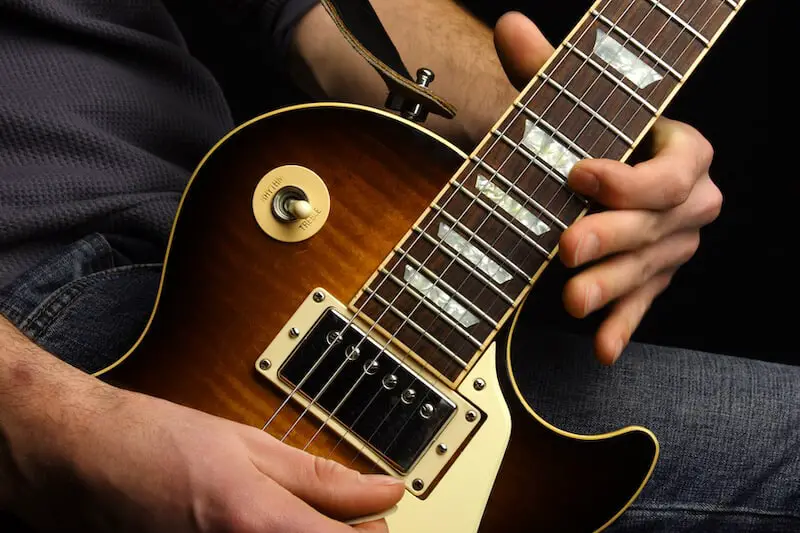Today I am going to explain how easy it is to press and bend electric guitar strings (compared to acoustic guitar strings.)
My experience playing acoustic and electric guitars has informed me about which is easier, and I have also learned the reasons why they are different.
Let’s compare playing a few types of guitars and take a look at why they feel different to play.
Are Electric Guitar Strings Easier to Press?
In my experience it is easier to press the strings of an electric guitar. The reason is that acoustic guitars typically require higher string tension. Acoustic guitars also typically have higher action so the strings need to be pressed further. Classical guitars fall into a middle ground in terms of ease of playing.

Are Electric Guitar Strings Easier to Bend?
Electric guitar strings are easier to bend. Again, this is because of the lower string tension. Also it is common for electric guitars to have lighter gauge strings which makes bending them easier.
This is why we don’t often see acoustic guitar players playing wild rock solos. Acoustic players are more likely to slide or use hammer ons and pull offs to approximate the effect of a bend.
Acoustic strings are generally so tight that they don’t want to budge. Even half step bends are a challenge, not to mention whole step and minor third bends.
Since bending increases pitch by adding additional tension, you run and increased risk of breaking an acoustic guitar string while bending it. Bending is a risk for electric guitar as well, but electric strings are designed to be bent and played aggressively.
If you try heavier gauge electric strings you will run into the same issue that you’ll find with acoustic guitar strings. But the thickness of the string itself is not the problem. Thick strings must have more tension to reach standard tuning. So a .13 string will be stiffer than a .10, when used as a high E string.
In other words, smaller gauge strings are easier to play because they are under less TENSION. And less tension makes the strings easier to move around for bends or other movements.
Are Electric Guitar Strings SOFTER than Acoustic Strings?
Electric guitar strings are not softer than acoustic strings, assuming they are made of the same type of metal.

When you purchase strings, notice whether the strings are made of steel, nickel, bronze, etc. These metals and alloys have different densities and magnetic properties. Remember that guitar pick-ups work because of magnetism and the vibration of metal strings.
If you are unsure of which strings you want, start with steel 10’s for electric and bronze 10’s for acoustic. Nickel is a softer metal and is a bit weaker in terms of magnetism. I have not tried nickel strings, but I doubt they would be significantly easier to play.
Nylon strings are softer than any type of metal strings, and have a warmer tone. However, nylon string guitars typically use metal strings for the low E, A, and D. Also, string tension is a much more significant factor in playing comfort than the actual hardness/density of the string material.
So again, pay attention to the tension.
Differences Between Electric and Acoustic Guitar Strings

1. Metal Material
Electric guitar strings are typically steel or nickel, whereas acoustic string materials are usually bronze, phosphor bronze, or nickel bronze. Classical guitar strings are made of nylon, and bronze for the lower strings.
2. Tension
Acoustic guitar strings requires higher tension to reach pitch. While this is not so much a quality of the strings themselves, it significantly impacts the way it feels to play an acoustic compared to an electric.
In fact, if you are primarily an acoustic guitar player and then you switch to electric guitar, the strings of the electric guitar will probably feel quite loose to you. Which is great if you found it difficult to press or bend the acoustic strings.
3. Action
Acoustic guitars typically use higher action than electric guitars. While this is related to the instrument design and set-up, not the strings themselves, it is highly relevant to the ease of playing the instrument.
If the strings sit farther from the frets, that means you have farther to move them each time you fret a note.
In other words, higher action = more effort.
Acoustic guitars have higher action, and so it does take more physical effort to press acoustic guitar strings than it does to fret electric guitar strings. And this effort increases further when playing chords.
4. G String
The G string of an acoustic guitar is typically wound (made by winding a wire around a core), while the G string of an electric guitar is typically unwound. This is probably because electric players are more likely to use this string for bending and wound strings are thicker and more difficult to bend.
So that’s another key difference between the strings you’ll find on acoustic and electric guitars.
Is it Easier to Play Electric Guitar? (Overall)
In my opinion, it is easier to play electric guitar. It is easier to press and bend the strings, the action is generally lower, the body is less bulky, its easier to play loud (if you have an amp), and the neck is generally more comfortable.
Electric guitars are easier to adjust as well. The action is typically adjustable with screws or hex keys on or near the bridge. To change the action of an acoustic guitar, it is more likely that you’ll have to raise or file the bridge and/or nut, or adjust the truss rod (if your guitar has one).
